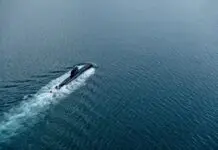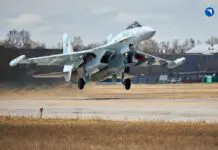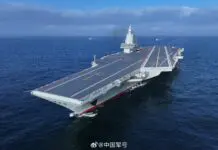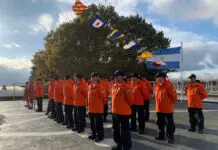Zona Militar had the privilege of conducting an interview with César Castro from Armor International, in charge of advertising, promotion, and media for the company. Armor International manufactures the 4×4 armored vehicle Hunter, currently in use by the Colombian National Army, National Police, and the Surinamese Army, albeit in small numbers across these institutions. The purpose of this interview is to gain firsthand insights into the modifications and current operational status of this MRAP (Mine-Resistant Ambush Protected), based on information provided directly by the manufacturer, avoiding speculation and errors to ensure accuracy for our readers.
This is a tactical personnel transport vehicle with a capacity for 12 occupants, usually carrying 10 personnel, a crew member, and a gunner. It is a multipurpose 4×4 tactical vehicle with an International chassis. Navistar Defense is a strategic ally for Armor in Latin America, authorized to use the chassis to assemble the Hunter TR 12, a Colombian-designed and manufactured vehicle specifically crafted in Bogotá. The aim is to provide a secure personnel transport solution in remote areas of the Colombian geography.

ZM: How did the strategic partnership with Navistar Defense come about?
“Navistar sought a reliable company with a strong track record and extensive experience in manufacturing armored systems for various vehicles. Armor International had already made progress with the Hunter TR 12 using other platforms, and Navistar recognized the success of this model. They partnered with Armor to offer the Colombian and Latin American Armed Forces a high-spec tactical vehicle at a much lower cost.”
ZM: Speaking of costs, what is the price of a new vehicle for a military force in dollars?
“The vehicle is surprisingly economical, being manufactured in Colombia. Prices start from $350,000 and can increase depending on the accessories added. Given its versatility, various accessories or devices can be installed, and different configurations can be acquired, leading to changes in the price.”

ZM: What level of armor does the vehicle have according to NATO Stanag standards?
“This vehicle we have here is Stanag level two, providing protection against mines and explosives with its V-shaped floor armor. It also offers protection against long firearms such as 7.62 and 5.56.”
ZM: Apart from the personnel transport version, what other versions does Armor International offer in the market?
“There are approximately 30 variants. This base can be used for different types of vehicles, including logistical, ambulance, command post, etc. It can also be customized with devices such as weapons or communication systems. In the case of personnel transport, it can be adapted for more or fewer occupants or a mix. Many variants are planned to cater to the diverse needs of different forces.”
ZM: Internationally, I understand the vehicle has already been sold abroad. Can you provide some information on those sales?
“Yes, one of the first units was sold to Suriname, and it is in operation under different conditions with the Surinamese Army. It has been offered to other countries in the process of acquisition, but these negotiations are quite lengthy.”
ZM: The vehicle has reportedly faced real combat situations. How has the Hunter performed in such situations?
“Yes, the vehicle has been involved in various parts of the country. It has demonstrated excellent performance, resisting attacks as promised. It protects against long firearms, has withstood long-range ammunition fire, mortar attacks, grenades, and even attacks with more powerful munitions. Thankfully, in over 13 or 14 years of operation, it has not overturned and has had no fatalities or injuries to lament in all its operations, starting from the first version.”
ZM: Since the first version, how many improvements or versions has the Hunter TR 12 undergone to reach the 2023 version?
“The vehicle has changed very little from the beginning to today. Technological improvements have been made to the chassis and electronics. In terms of armor, structure, design, spaces, and troop distribution specifications, they remain very similar because it was initially designed for the Colombian Public Force. The changes are minor, such as adding accessories. What has evolved significantly is the electronics, the chassis change to International, and the inclusion of telemetry technology, giving the forces absolute control over the vehicle.”
ZM: How many units are currently in operation in different forces, and who acquired them?
“Initially, they were not sold to the Police or the Army but were acquired and donated by Ecopetrol, the Meta governorship, and the National Roads Institute. Currently, two are operational in the Police, and six are in the Army.”
ZM: It has been mentioned that another four TR 12 vehicles were acquired in 2023. Can you confirm this version?
“Yes, four units are in the process of acquisition.”
Author’s note: On this question and after thoroughly reviewing the state contracting page, the author could not find any open processes as of the date, although negotiations may be underway for the purchase.
ZM: I’d like to ask about another product, the Hunter XL, which the National Army has one unit of in the special forces battalion. Can you provide a brief description of the vehicle?
“The Hunter XL uses the same design as the Hunter TR 12 in terms of the hull construction, with the difference that it accommodates more personnel, up to approximately 16 people, and increases its level of protection against AP ammunition. It uses an International engine and military chassis, much more complex, similar to that used by the Republic of Colombia Navy in its transport trucks.”

Appreciating the attention from Armor International, we can draw some conclusions about the past, present, and future of this significant national development. Firstly, in the past, the military officials did not support the national industry, preferring the purchase of much more expensive vehicles, which, although better in features, proved to be an unnecessary expense, such as the LAV III acquired in 2013. Without the support of other state institutions, the Hunter would have faced failure. Another conclusion is that the leadership is still not aware of the utility and benefits of protecting troops, while soldiers and police continue to die on Colombian roads. Acquiring vehicles with a unit cost of 5.6 million dollars, which could purchase up to 16 Hunters, protecting 192 men, seems to be a capricious and blind decision by officers making purchases of armored vehicles.
All specialists and members of the Armed Forces who have used the vehicle praise its characteristics. Some owe their lives to it, and its capabilities for the Colombian conflict are clear. It is combat-tested, with its armor resisting explosions and gunfire used by criminal groups who target our uniformed personnel.
Hopefully, one of the decision-making officers for military acquisitions will have the capacity and determination to procure what is necessary so that our soldiers do not die needlessly on Colombian roads.
You may also like: The United States Space Force plans to deploy logistics and service satellites










